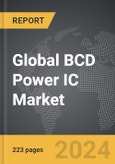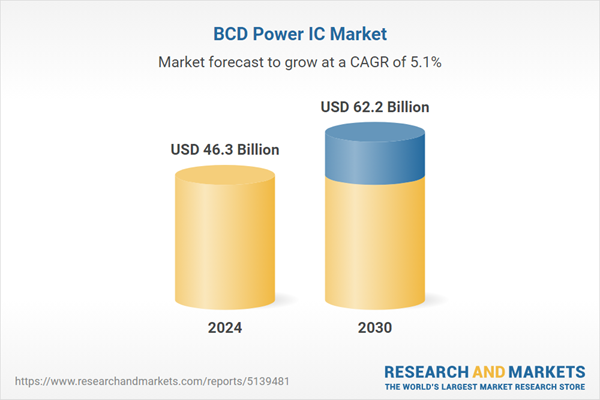The global market for BCD Power IC was valued at US$46.3 Billion in 2024 and is projected to reach US$62.2 Billion by 2030, growing at a CAGR of 5.1% from 2024 to 2030. This comprehensive report provides an in-depth analysis of market trends, drivers, and forecasts, helping you make informed business decisions. The report includes the most recent global tariff developments and how they impact the BCD Power IC market.
Segments: End-Use (ICT, Consumer Electronics, Automotive, Other End-Uses).
Geographic Regions/Countries: World; United States; Canada; Japan; China; Europe (France; Germany; Italy; United Kingdom; and Rest of Europe); Asia-Pacific; Rest of World.
The analysts continuously track trade developments worldwide, drawing insights from leading global economists and over 200 industry and policy institutions, including think tanks, trade organizations, and national economic advisory bodies. This intelligence is integrated into forecasting models to provide timely, data-driven analysis of emerging risks and opportunities.
Global BCD Power IC Market - Key Trends and Drivers Summarized
Why Are BCD Power ICs Critical in Modern Electronics?
BCD (Bipolar-CMOS-DMOS) Power ICs represent a critical innovation in semiconductor technology, integrating three distinct types of transistors - Bipolar, CMOS, and DMOS - onto a single chip. This integration allows BCD Power ICs to combine the high-speed processing capabilities of CMOS with the high-voltage handling and efficiency of DMOS, and the precise analog functions of Bipolar transistors. These ICs are designed to handle the power management needs of various electronic devices, providing efficient voltage regulation, power conversion, and control in a compact form factor. BCD technology is particularly advantageous because it allows for high-density integration, which means more functionality can be packed into a smaller space, reducing the size and cost of electronic devices. This makes BCD Power ICs indispensable in applications ranging from consumer electronics to industrial automation, where efficient power management is crucial for performance and reliability.How Are Technological Advancements Driving Innovation in BCD Power ICs?
Technological advancements are significantly driving innovation in BCD Power ICs, making them more efficient, reliable, and adaptable to a wider range of applications. One of the most notable advancements is the improvement in semiconductor manufacturing processes, which has enabled the development of BCD ICs with smaller geometries and higher integration levels. This has led to increased performance, lower power consumption, and reduced heat generation, which are essential for modern electronic devices that demand both high efficiency and compact designs. Additionally, advancements in materials science, particularly the use of advanced dielectric materials and metal-oxide-semiconductor structures, have enhanced the voltage handling capabilities and overall durability of BCD Power ICs. These innovations are not only improving the performance of existing applications but are also opening up new possibilities for BCD technology in emerging fields such as electric vehicles, renewable energy systems, and advanced robotics, where power efficiency and compact design are paramount.Why Is the Demand for BCD Power ICs Increasing Across Various Industries?
The demand for BCD Power ICs is rapidly increasing across various industries due to their ability to meet the evolving power management needs of modern electronic systems. In the automotive industry, the shift towards electric vehicles (EVs) and advanced driver-assistance systems (ADAS) has created a significant demand for high-efficiency power management solutions that can handle the complex and high-voltage environments of these applications. BCD Power ICs, with their ability to integrate multiple power management functions onto a single chip, are ideal for these applications, providing both the high voltage handling and precise control needed for efficient operation. Similarly, in the industrial sector, the rise of automation and the Internet of Things (IoT) is driving demand for compact, reliable power management solutions that can operate in harsh environments. BCD Power ICs are increasingly being used in these applications due to their robustness and ability to deliver stable performance under varying conditions. The consumer electronics market is also a major driver, with the growing demand for smaller, more efficient devices pushing manufacturers to adopt BCD technology to achieve the necessary power efficiency and form factor.What Forces Are Propelling the Growth of the BCD Power IC Market?
The growth in the BCD Power IC market is driven by several key forces, including the rapid expansion of the electric vehicle sector, which demands sophisticated power management solutions that can handle high voltages and ensure precise control. Advances in semiconductor manufacturing technology are also playing a crucial role, enabling the development of smaller, more efficient BCD ICs that can be utilized across a broader range of applications. Additionally, the increasing adoption of automation and IoT in industrial environments is fueling demand for robust, reliable power management systems, making BCD Power ICs an attractive choice. The consumer electronics industry is also contributing to market growth, as the push for more compact, energy-efficient devices drives manufacturers to incorporate BCD technology. As these trends continue to gain momentum, the BCD Power IC market is set for continued expansion, driven by innovation and the escalating need for efficient power management in modern electronic systems.Report Scope
The report analyzes the BCD Power IC market, presented in terms of units. The analysis covers the key segments and geographic regions outlined below.Segments: End-Use (ICT, Consumer Electronics, Automotive, Other End-Uses).
Geographic Regions/Countries: World; United States; Canada; Japan; China; Europe (France; Germany; Italy; United Kingdom; and Rest of Europe); Asia-Pacific; Rest of World.
Key Insights:
- Market Growth: Understand the significant growth trajectory of the ICT End-Use segment, which is expected to reach US$29.9 Billion by 2030 with a CAGR of a 4.5%. The Consumer Electronics End-Use segment is also set to grow at 6.0% CAGR over the analysis period.
- Regional Analysis: Gain insights into the U.S. market, valued at $12.7 Billion in 2024, and China, forecasted to grow at an impressive 4.9% CAGR to reach $9.9 Billion by 2030. Discover growth trends in other key regions, including Japan, Canada, Germany, and the Asia-Pacific.
Why You Should Buy This Report:
- Detailed Market Analysis: Access a thorough analysis of the Global BCD Power IC Market, covering all major geographic regions and market segments.
- Competitive Insights: Get an overview of the competitive landscape, including the market presence of major players across different geographies.
- Future Trends and Drivers: Understand the key trends and drivers shaping the future of the Global BCD Power IC Market.
- Actionable Insights: Benefit from actionable insights that can help you identify new revenue opportunities and make strategic business decisions.
Key Questions Answered:
- How is the Global BCD Power IC Market expected to evolve by 2030?
- What are the main drivers and restraints affecting the market?
- Which market segments will grow the most over the forecast period?
- How will market shares for different regions and segments change by 2030?
- Who are the leading players in the market, and what are their prospects?
Report Features:
- Comprehensive Market Data: Independent analysis of annual sales and market forecasts in US$ Million from 2024 to 2030.
- In-Depth Regional Analysis: Detailed insights into key markets, including the U.S., China, Japan, Canada, Europe, Asia-Pacific, Latin America, Middle East, and Africa.
- Company Profiles: Coverage of players such as Alpha and Omega Semiconductor Limited, Diodes, Inc., Globalfoundries, Inc., Infineon Technologies AG, Kingpex Technology, Inc. and more.
- Complimentary Updates: Receive free report updates for one year to keep you informed of the latest market developments.
Some of the 41 companies featured in this BCD Power IC market report include:
- Alpha and Omega Semiconductor Limited
- Diodes, Inc.
- Globalfoundries, Inc.
- Infineon Technologies AG
- Kingpex Technology, Inc.
- MagnaChip Semiconductor Corp.
- onsemi
- STMicroelectronics NV
- Taiwan Semiconductor Manufacturing Co., Ltd. (TSMC)
- Texas Instruments, Inc.
Tariff Impact Analysis: Key Insights for 2025
Global tariff negotiations across 180+ countries are reshaping supply chains, costs, and competitiveness. This report reflects the latest developments as of April 2025 and incorporates forward-looking insights into the market outlook.The analysts continuously track trade developments worldwide, drawing insights from leading global economists and over 200 industry and policy institutions, including think tanks, trade organizations, and national economic advisory bodies. This intelligence is integrated into forecasting models to provide timely, data-driven analysis of emerging risks and opportunities.
What’s Included in This Edition:
- Tariff-adjusted market forecasts by region and segment
- Analysis of cost and supply chain implications by sourcing and trade exposure
- Strategic insights into geographic shifts
Buyers receive a free July 2025 update with:
- Finalized tariff impacts and new trade agreement effects
- Updated projections reflecting global sourcing and cost shifts
- Expanded country-specific coverage across the industry
Table of Contents
I. METHODOLOGYII. EXECUTIVE SUMMARY2. FOCUS ON SELECT PLAYERSIII. MARKET ANALYSISIV. COMPETITION
1. MARKET OVERVIEW
3. MARKET TRENDS & DRIVERS
4. GLOBAL MARKET PERSPECTIVE
UNITED STATES
CANADA
JAPAN
CHINA
EUROPE
FRANCE
GERMANY
ITALY
UNITED KINGDOM
REST OF EUROPE
ASIA-PACIFIC
REST OF WORLD
Companies Mentioned (Partial List)
A selection of companies mentioned in this report includes, but is not limited to:
- Alpha and Omega Semiconductor Limited
- Diodes, Inc.
- Globalfoundries, Inc.
- Infineon Technologies AG
- Kingpex Technology, Inc.
- MagnaChip Semiconductor Corp.
- onsemi
- STMicroelectronics NV
- Taiwan Semiconductor Manufacturing Co., Ltd. (TSMC)
- Texas Instruments, Inc.
Table Information
| Report Attribute | Details |
|---|---|
| No. of Pages | 223 |
| Published | April 2025 |
| Forecast Period | 2024 - 2030 |
| Estimated Market Value ( USD | $ 46.3 Billion |
| Forecasted Market Value ( USD | $ 62.2 Billion |
| Compound Annual Growth Rate | 5.1% |
| Regions Covered | Global |








